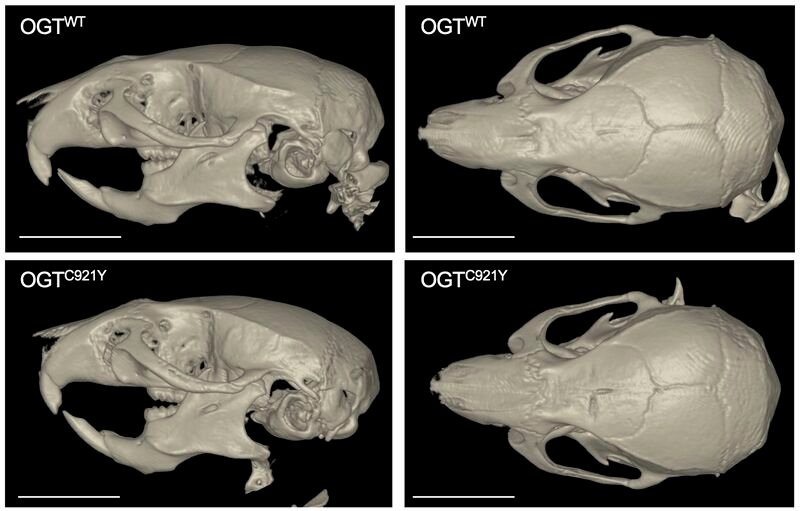Latest paper of Daan van Aalten Lab at Molecular Biology & Genetics – Aarhus University by Florence Authier, PhD, Andrew Ferenbach in collaboration with Nina Ondruskova and Alison McNeilly (dundee) on trying to understand the mechanisms underpinning O-GlcNAc transferase X-linked intellectual disability (aka OGT-CDG). The team has managed to generate mouse models carrying three different patient OGT-CDG variants that recapitulate many of the symptoms (e.g. microcephaly) and point to disruption of O-GlcNAc homeostasis as the probable underlying mechanism.
Background
O-GlcNAcylation, a post-translational modification catalyzed by the enzyme O-GlcNAc transferase (OGT), is crucial for vertebrate development. Mutations in OGT have been identified in patients with intellectual disability, leading to a condition termed OGT-CDG. This disorder is associated with neurodevelopmental impairments, but the precise mechanisms through which OGT mutations affect brain function have remained unclear.
The researchers generated mouse models with specific OGT mutations to investigate the effects of these mutations on brain development and function. These models exhibited significant neurodevelopmental defects, including reduced brain size, hyperactivity, and memory impairments, closely mirroring the symptoms observed in human OGT-CDG patients.
Key Findings
- Reduction in Brain Size: The OGT-mutant mice displayed a notable decrease in brain size, indicating that O-GlcNAcylation is critical for normal brain development.
- Hyperactivity and Memory Deficits: Behavioral analyses revealed that these mice were hyperactive and exhibited substantial memory deficits, underscoring the role of OGT in cognitive functions.
- Synaptic Function and Neuronal Structure: The study highlighted that O-GlcNAcylation is pivotal for synaptic maturation and function, as well as neuronal morphology, which are essential for learning and memory.
This study is crucial for several reasons:
- Mechanistic Insights: It provides detailed mechanistic insights into how mutations in OGT lead to intellectual disability, enhancing our understanding of the molecular basis of OGT-CDG.
- Model for Further Research: The mouse models developed in this research are invaluable tools for studying the pathophysiology of OGT-CDG and for testing potential therapeutic interventions.
- Therapeutic Potential: Understanding the role of O-GlcNAcylation in brain development opens new avenues for developing targeted treatments for OGT-CDG and potentially other related neurodevelopmental disorders.
The findings of this research mark a significant advancement in the field of neurogenetics and underscore the critical role of O-GlcNAcylation in brain function. This paper not only enhances our understanding of OGT-CDG but also sets the stage for future research aimed at developing effective treatments for this and similar disorders.
We encourage the scientific community and stakeholders in the field of genetic research and neurodevelopmental disorders to delve into this comprehensive study to further our collective efforts in combating intellectual disabilities linked to genetic anomalies.
Link to the paper.

